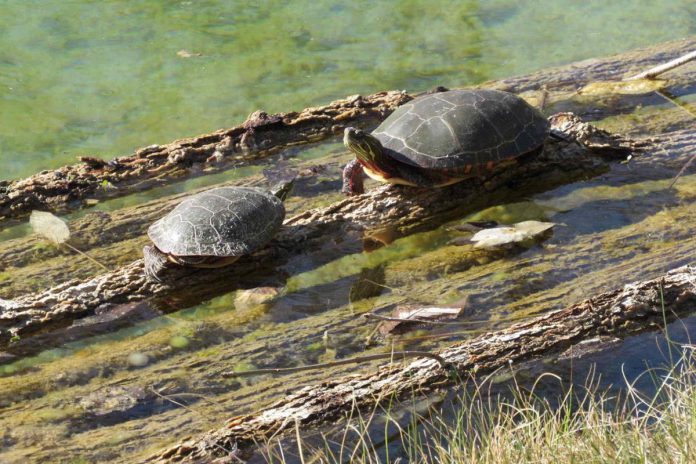
The recent protection of two Kawartha Lakes properties “will support cleaner air, water, soil, and food security” for future generations, according to Kawartha Land Trust (KLT) executive director John Kintare.
KLT has announced that, as a result of forward-thinking and nature-minded landowners, the land conservation organization has been able to protect an additional 147 acres of nature and agricultural lands in the City of Kawartha Lakes, including 91 acres within the Stoney Creek watershed that have donated to the KLT and 56 acres of natural lands in the Pigeon Lake subwatershed that are protected through a conservation easement agreement.
“With the protection of these ecologically significant lands, we are caring for nature and working lands in Kawartha Lakes today and protecting potential for tomorrow and in the years ahead,” Kintare told kawarthaNOW.
“Decades from now, these wildlife corridors will remain conserved; woodland, wetland, and grassland species supported; and the agricultural land at KLT’s Stoney Creek Meadow still in use,” Kintare said.
“These lands will support cleaner air, water, soil, and food security in the region. As a father and resident of Kawartha Lakes, this makes me hopeful about the future and proud of our community for protecting these natural assets.”
Located within the Stoney Creek watershed, KLT describes the Stoney Creek Meadow nature reserve as a wildlife haven. The two landowners of the 91 acres, who wish to remain anonymous, donated the land to KLT to ensure its permanent protection.
“The owners loved this land for generations, but realized they could not care for it long into the future,” Kintare said. “We’re extremely grateful for the trust they put in Kawartha Land Trust to help create their conservation legacy and ensure both nature and agriculture in the region continue to thrive.”
Protecting land also protects corridors for wildlife to travel safely across the land to their habitats. According to KLT, wildlife corridors make up almost half of KLT’s Stoney Creek Meadow.
The property will also be an example of co-existing active agriculture and active land stewardship activities. Before it was donated to KLT, a portion of KLT’s Stoney Creek Meadow was used as pasture by a local farmer for light cattle grazing. KLT will continue to allow sustainable cattle grazing in a section of the pasture while also planning to restore a meadow for grassland birds species like grasshopper sparrow, eastern meadowlark, and bobolink in another section of the pasture.
The State of Canada’s Birds, a 2024 report from Birds Canada and Environment and Climate Change Canada, notes that Canada’s grassland-dependant birds have experienced a 67 per cent decline in their populations since 1970 — the most out of any other groups of birds in the country.
As for Kawartha Lakes residents Mark Maitman and Dale Sutton, they have ensured the permanent protection of their 56-acre property by entering into a conservation easement agreement (CEA) with KLT.
Conservation easement agreements allow property owners to retain private ownership and management of their land but limit what they and any future owners can do on the property, with the intent of protecting wildlife, habitats, shoreline, water quality and quantity, or other natural, agricultural, and other cultural features in perpetuity.
The Maitman-Sutton CEA consists of 56 acres of deciduous forest, mixed swamp, and meadow, with 90 per cent of the property consisting of a wildlife corridor.
“Every day, we are reminded of the interconnectedness of everything on this earth and how fragile the health of the land, the water, the air, and all of us who share this planet are,” Maitman and Sutton said in a joint statement. “Perhaps we cannot do much to mitigate climate change at a macro level, but we can affect this small area. We can do something.”
KLT noted the permanent protection of KLT’s Stoney Creek Meadow and Maitman-Sutton CEA were supported by funding received from Environment and Climate Change Canada’s Nature Smart Climate Solutions Fund. In addition, portions of both conservation projects were donated to KLT through the Government of Canada’s ecological gifts program.
KLT now protects 46 properties that encompass more than 8,250 acres of natural and working lands in the Kawarthas, with 2,400 acres in Kawartha Lakes including Stoney Creek Meadow, Maitman-Sutton CEA, Cation Wildlife Preserve in Coboconk, and Ballyduff Trails in Pontypool.
While Cation Wildlife Preserve and Ballyduff Trails are open to the public and are popular destinations for hikers, birders, and nature lovers, neither Stoney Creek Meadow and Maitman-Sutton CEA are open to the public.
Meanwhile, KLT will be making an announcement on Friday (November 7) that it has permanently protected a 435-acre property in the Municipality of Trent Lakes known as the Kawartha Highlands South nature reserve, which is bordered on three sides by Kawartha Highlands Provincial Park.
The event will acknowledge the donors and funding agencies that made this protection possible and share information about future community hiking trails on the property.


























